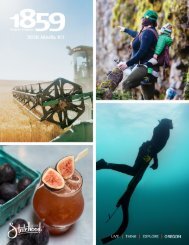Create successful ePaper yourself
Turn your PDF publications into a flip-book with our unique Google optimized e-Paper software.
In 2006, Yaz was living in Eugene, Oregon, and leading a small rowing<br />
club when she got a call from Stanford. With no high-level coaching<br />
experience, the two-time Olympian wasn’t sure she was qualified for the<br />
job. “You never know if being an athlete translates into being a good coach,”<br />
she said. Even now, she struggles to name the few elite coaches who came<br />
from coxing. Nonetheless, the sprite of a woman accepted the coaching<br />
position and led the program to a second-place finish in her second year.<br />
Stanford hadn’t been among the top three finishers in its history. In her<br />
third year, however, Yaz and her team won the NCAA championship.<br />
Gone was the doubt that a cox could steer one boat, but not a whole team.<br />
Her coaching career was on fire.<br />
Over the course of her ten-year tenure at Stanford, the coxswainturned-coach<br />
would lead the Cardinal women’s rowing team to its best<br />
run in its history. When she first took the Stanford coaching job in 2006,<br />
her husband asked if there was any other coaching job that would entice<br />
her to leave Stanford. Washington, she replied.<br />
In 2016, UW called.<br />
The resignation letter from the Stanford Athletics Department<br />
showered her with praise. It would miss the coach who took the program<br />
from obscurity to spotlight. Perhaps more troubling for Stanford was that<br />
she’d be the coach of its Pac-12 arch rival. “She has invested a great deal<br />
into the program and built Stanford into a perennial title contender,” the<br />
athletic department wrote. “An Olympian and United States team captain<br />
herself, Yaz knows what it takes to compete and lead on the sport’s<br />
biggest stage.”<br />
In her first year at University of Washington, Yaz would have the<br />
daunting task of measuring up to the performance of long-time departing<br />
coach, Bob Ernst. She changed how the team trained with more on-water<br />
volume, she shuffled boat assignments and brought order to a fractious<br />
team, which had dismissed its coach in a controversial mid-season ruckus.<br />
“There are a lot of ways to go fast,” Yaz noted. “The training that I did<br />
on the national-team level involved doing more aerobic base training and<br />
volume. That’s what I implemented for them. They had a history of starting<br />
fast, but fading before the finish line. The hardest thing in the beginning<br />
was to get them to row with less intensity for longer periods of time—to<br />
build what I call ‘the capillary superhighway.’”<br />
She became the first coach to win the NCAA championship at two<br />
schools. That performance was remarkable enough to make her the 2017<br />
Collegiate Rowing Coaches National Coach of the Year.<br />
A<br />
YOUNG TEAM, ALL ROWERS FROM THE 2017<br />
championship team have returned for another crack.<br />
Into the water they went, the shells cutting sharply<br />
through the 45-degree morning air, three boats of eight<br />
slicing through Montlake Cut. They slid past the old<br />
boathouse where the 1936 team trained and George<br />
Pocock made his shells. In the fog around them, the ghosts of history<br />
mingled with the prospect of making history again at the NCAA rowing<br />
championships in Sarasota, Florida.<br />
Elise Beuke pulled steadily along, her blades slicing into the darkness of<br />
Lake Union.<br />
Beuke, a 20-year-old sophomore, learned how to row in Sequim Bay<br />
on the northern coast of the Olympic Peninsula. Her dad, a middle<br />
school history teacher and cyclist, decided his kids would get involved in<br />
ROWING TERMS<br />
SHELL: a racing hull with<br />
alternating single oar mountings<br />
SCULL: a racing hull with double<br />
oars for each rower<br />
EIGHTS: an eight-oar boat with<br />
one cox<br />
VARSITY EIGHT: the top eight<br />
boat for any team<br />
SECOND-VARSITY EIGHT: the<br />
second-fastest eight on a team<br />
FOUR: a four-person boat<br />
DOUBLE: a two-person boat<br />
POSITIONS IN AN EIGHT: The<br />
seats are numbered from the<br />
bow, or front, to the stroke or last<br />
rower before the cox in the stern<br />
COX: the person without an oar<br />
who steers the boat with a rudder<br />
and deploys race strategy<br />
STROKE: the rower closest to the<br />
cox (the 8 seat) and responsible<br />
for setting stroke rate and rhythm,<br />
the first member of the stern pair.<br />
STROKE LIEUTENANT: the seat<br />
behind the Stroke (7), the second<br />
member of the stern pair, who<br />
interprets the Stroke’s rate for<br />
rowers on the right side of the<br />
boat<br />
ENGINE ROOM: generally seats<br />
3-6 that provide the bulk of the<br />
strength<br />
BOW: the last seat (1) on the<br />
eight<br />
THE RACE COURSE<br />
The standard championship<br />
race is 2,000 meters. The<br />
course must be wide enough to<br />
accommodate six lanes, or 298<br />
feet, 7 inches.<br />
Boats are aligned at the start<br />
by focusing a vertical wire on a<br />
vertical stripe on the far side of<br />
the start.<br />
Floating markers come in the<br />
first 100 meters, denoting the end<br />
of the start zone and at every 250-<br />
meter interval to the finish.<br />
Judges and cameras at the finish<br />
line determine results.<br />
FEBRUARY | MARCH <strong>2018</strong> <strong>1889</strong> WASHINGTON’S MAGAZINE 57

















